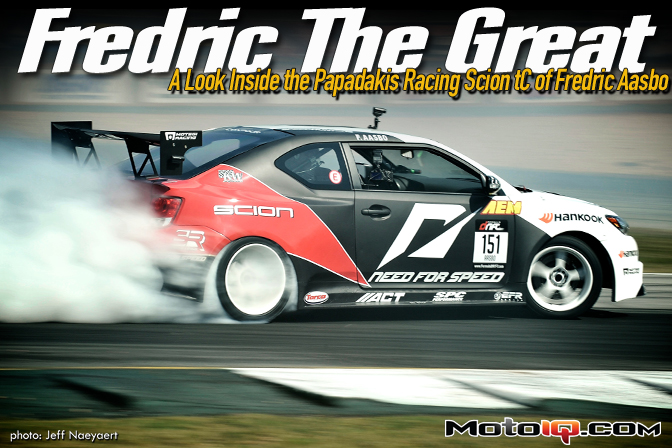,
 |
| The exhaust ports are much smaller than the intakes and to balance the flow between them, the exhaust ports are fully ported by Tom Fujita of Portflow Design. |
 |
| You can see the details of the fully enlarged exhaust port in this close up. The head also gets Portflow’s radius valve job and unshrouding. |
The Scion’s engine is actually pretty simple; it is a 2.7 liter 1AR-FE from a late model Toyota Sienna van. It is a huge 4 cylinder with a 90mm bore and a 105mm stroke. It has an all alloy open deck block and a fully counterweighted stout forged steel crank. The DOHC cylinder head has variable cam timing on both the intake and exhaust sides. If there was to be a 4 cylinder that could bring the fight to the V8 revolution this engine would be it. The 1AR-FE is a torque monster capable of spooling a turbo quickly for fast response and tons of low end torque.
 |
| The Toyota 1AR-FE uses an open combustion chamber with no quench. Not the best for boosted combustion. Note the stock valves and the polished and deburred combustion chamber. Note how the area where the valves are close to the ends of the combustion chamber are laid back to unshroud them. |
Papadakis racing set about turbocharging the engine, fortifying the innards with forged JE pistons and some secret spec connecting rods. Since the cylinder heads are an open chamber design the pistons have detonation fighting quench machined right into the dome of the piston. The pistons are forged from high strength 2618 low silicon alloy and feature thin low tension piston rings which are critical due to the high piston speeds that the long 105mm stroke creates. Light, low tension rings resist seal killing flutter at high piston speeds. 2618 alloy tends to be noisy and rattley due to its high expansion ratio which requires a greater piston to wall clearance. Even with this characteristic, 2618 is much more ductile and resistant to detonation than the high silicon alloys that are more suitable for street cars.
 |
| To create quench in an open chamber head, JE designed these pistons with built in quench pads. This is a really cool way to do it. |
Papadakis racing would not allow us to see the connecting rods. We think that they might be something really special, perhaps something super light to combat inertial stress or maybe longer to improve the stroke to rod ratio and reduce piston speed. Whatever it is the rods were secret and we don’t know what they are for sure.
 |
| We think that the engine uses a long rod due to the pin placement of the pistons. Papadakis Racing was reluctant to show us the connecting rods. Note how the pin is almost into the oil ring groove. Don’t tell Steph we see this! The piston uses narrow low tension rings with a pressure accumulation groove between the first and second compression rings. This is needed due to the high piston speeds the 105mm stroke creates. |
 |
| The piston is an unremarkable full skirted design probably to help with stability in the bore with the super long stroke. The pistons also lack pin oilers probably due to needed strength because of the stress imparted by the long stroke. The pistons are forged from tough low silicon 2618 alloy. |
 |
| Steph modifies the upper oil pan. |
Related











1 comment
Ese piston lo fabrican para motor 1ARFE?